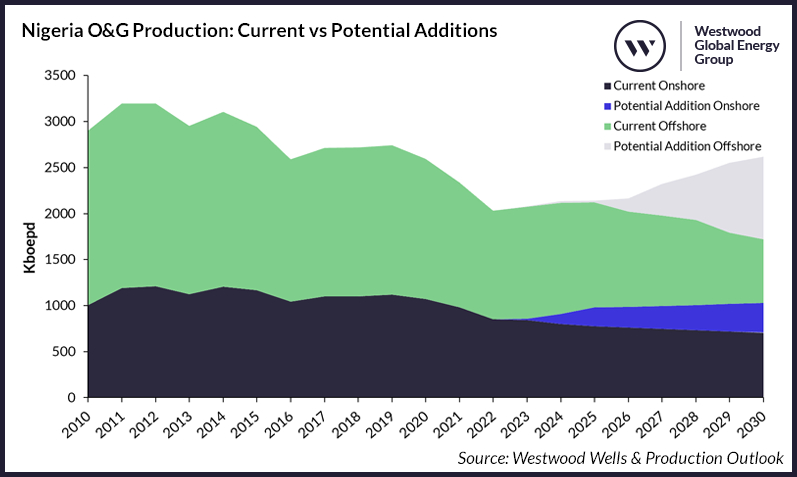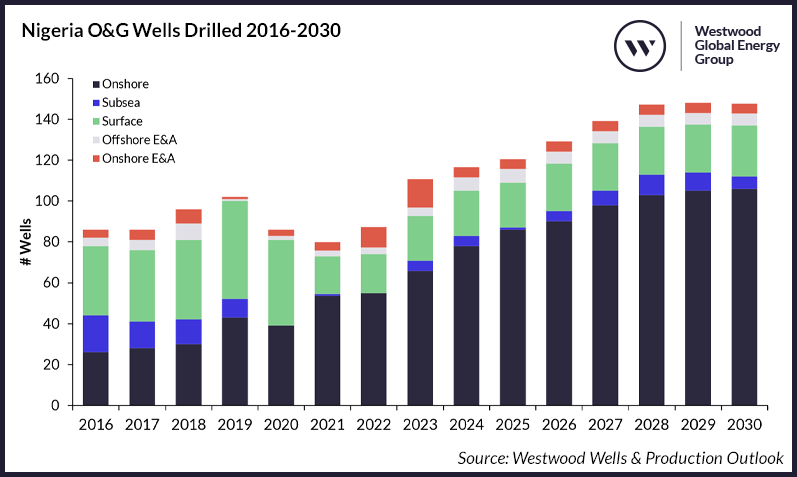
Westwood Global Energy projects Nigeria’s oil and gas sector will liven up with 140 new wells drilled year-on-year to 2030. (Source: Shutterstock.com)
Newly introduced reforms could improve Nigeria’s flagging oil and gas production levels, Westwood Global Energy Group said Aug. 24.
Nigeria, which has historically been Africa’s largest oil producer, has struggled to maintain its oil and gas potential output for much of the last decade. The country holds 37 Bbbl of oil and 206 Tcf of gas. However, production currently is well below the average output between 2010 and 2015 of 3 MMboe/d.
The Nigerian government has an ambitious goal of doubling production from 1.3 MMbbl/d in 2022 to 2.6 MMbbl/d by 2027.
Westwood attributes diminished production, in part, to an estimated 74% reduction in upstream capex from $27 billion in 2014 to $6 billion in 2022, as reported by the Nigerian Upstream Petroleum Regulatory Commission (NUPRC). But domestic reforms, particularly for deepwater, could revitalize the oil and gas industry, Westwood said.
One of those is the Petroleum Industry Bill of 2021, initially proposed in 2008, which paved the way for the privatization of the Nigerian National Petroleum Corp. (NNPC). Under a clause in the bill, 30% of NNPC’s profits are to be reinvested in the soon-to-be introduced Frontier Exploration Fund. That will allow for a greater focus on exploration of the country’s main frontier basins.
The government has also made progress in addressing security instability and oil theft, which have been a continuous bottleneck for the industry, according to Westwood.
While Westwood expects there to be growth, given the projects on the horizon, the analysts forecast a Nigerian oil production output of 1.9 MMbbl/d by 2030.
The firm noted that projects expected to support the increased production have historically been delayed. Some of the notable near-term offshore projects include TotalEnergies’ Preowei Phase I development, expected to be sanctioned soon and produce 65,000 bbl/d starting in 2026, and an additional 120,000 bbl/d from Shell’s Bonga North starting in 2027. First oil from Exxon Mobil’s Owowo and Bosi fields is expected in 2029 and 2030, respectively.
In terms of gas production, Shell’s HI and HA shallow water developments are expected onstream in 2027 and 2029, respectively. Should all of these projects go online as scheduled, they will boost overall oil and gas production to 2.6 MMboe/d by 2030, according to Westwood.

Exploration, new drilling
With new exploration blocks opening up, there is the potential for production to exceed Westwood’s expectations.
In January, companies bid for seven ultradeep offshore blocks in a mini-exploratory bid round. In 2020, 57 marginal oil and gas fields in land, swamp and shallow water areas were awarded to 24 indigenous players.
Also in 2020, NNPC reportedly had an onshore discovery of 1 Bbbl and 500 Bcf of gas in the Kolmani area in Northern Nigeria. NNPC also spudded in May the Wadi-B appraisal well in the frontier Lake Chad Basin targeting a prospect that has been abandoned since the 1980s.
In the same month, the NNPC also spudded the Ebenyi-A exploration well in OPL 826 in Borno State.
Geoplex, a local oil field services company, plans a development program in the offshore Indibe Field in OML 67, with first oil anticipated later this year.
From the development of these discoveries, Westwood said it anticipates drilling activities to increase between 2023 and 2030 and forecasts an average of 140 development wells to be drilled year-on-year through 2030. This will be driven by onshore activity through increased infill drilling to maintain current production levels in Nigeria’s aging oil fields and development drilling from marginal fields that were part of recent leasing rounds.
The firm also expects deepwater drilling to slightly increase from 2026 onwards in preparation for the development of Shell’s Bonga Southwest-Aparo field, Chevron’s Nsiko, TotalEnergies’ Preowei Phase II development and Exxon Mobil’s Uge oil fields, which are all set to start producing post-2030. Infill drilling in deepwater is likely to continue, with the most recent example being the drilling of up to 11 infill wells in TotalEnergies’ Egina and Akpo fields starting in third-quarter 2023.
In shallow waters, Westwood’s RigLogix said that the number of active jackup rigs has been stagnant, averaging 3.5 since 2021, following nine active jackup rigs in 2019, which dropped to 7.5 in 2020. Westwood said it anticipates some gentle uplift in shallow water drilling activity over the forecast period but that activity is not expected to return to pre-2021 levels.

Production targets likely elusive
While Nigeria, an OPEC member, recently agreed to a production quota of 1.38 MMbbl/d in 2024, since May 2020 Nigeria has produced below its quota, averaging 1.3 MMbbl/d. Westwood believes the 2024 production quota could limit near-term growth and said it’s unlikely crude production will surpass 1.38 MMbbl/d by the end of 2024.
Westwood cautioned that production quotas at current levels beyond 2024 could have a lasting impact on forecast production growth.
The country may not be in a position to hit its targets, Westwood said, but the country is setting a solid foundation to capitalize on the energy deficit registered in European nations and hydrocarbon demand from industrializing nations such as China and India by the end of the forecast period. However, Nigeria must tackle its infrastructure and security problems and continue to create an attractive business environment to entice local players and encourage international energy companies to keep investing in assets they currently hold, especially offshore.
Westwood anticipates that the coming years will pose an opportunity for domestic oil companies to take the front seat in onshore and shallow water exploration, with drilling and production expected to grow until at least 2030.
Recommended Reading
Halliburton, Nabors Collab to Deploy Drilling Automation in Oman
2025-04-15 - The companies integrated Halliburton’s Logix automation with Nabors Industries’ SmartROS rig operating system.
Exclusive: Halliburton's E-Fleets Lower Haynesville Completions Costs
2025-04-14 - Halliburton’s Neil Modeland, senior business technology development manager, shares insight into the company’s electrification services and efforts to minimize associated completions costs in the Haynesville Shale, in this Hart Energy Exclusive interview.
Nabors, Corva Expand Alliance to Boost AI-Driven Innovation at Rig Sites
2025-04-13 - Nabors Drilling Technologies and Corva AI will use the RigCloud platform to provide real-time insights to crews directly at drilling sites, the companies said.
Inside Prairie’s 11-Well Program in the D-J
2025-04-08 - Prairie Operating Co.’s 11-well program in the Denver-Julesburg Basin is drilling horizontal 2-milers with a Precision Drilling rig.
Woodside Awards SLB Drilling Contract for Project Offshore Mexico
2025-03-31 - SLB will deliver 18 ultra-deepwater wells for Woodside Energy’s Trion ultra-deepwater project starting in early 2026.
Comments
Add new comment
This conversation is moderated according to Hart Energy community rules. Please read the rules before joining the discussion. If you’re experiencing any technical problems, please contact our customer care team.





